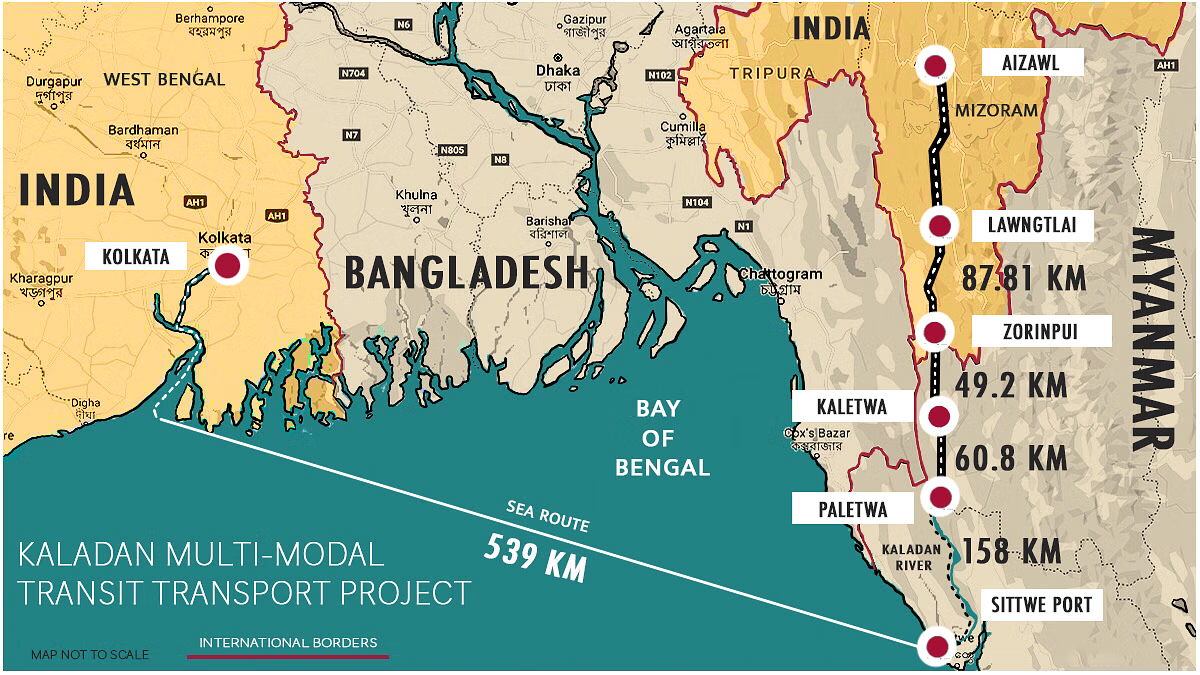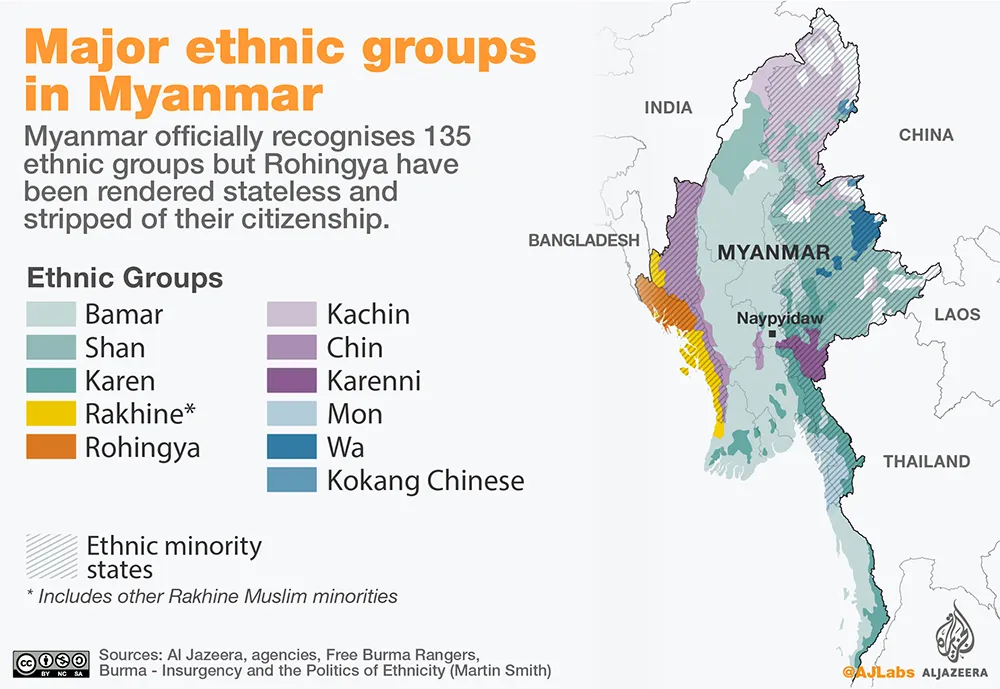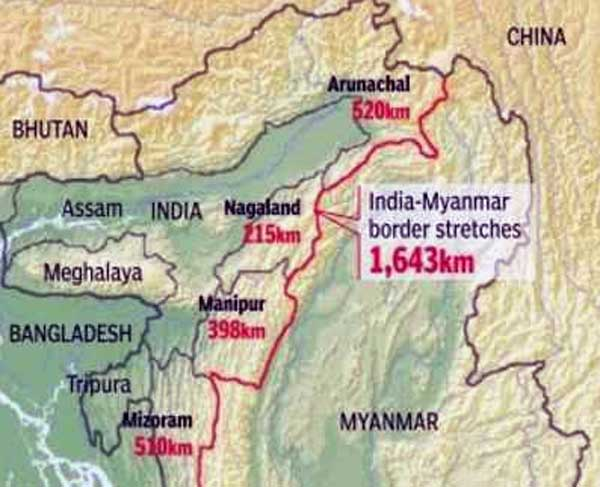International Relations
India-Myanmar Ties: Fencing The Free Movement
- 03 Feb 2024
- 17 min read
This editorial is based on “ Finding light in Myanmar’s darkness” which was published in The Hindu on 01/02/2024. The article delves into the contemporary difficulties in the diplomatic ties between India and Myanmar, examining the current challenges and proposing potential solutions.
For Prelims: Free Movement Regime (FMR), Act East Policy, ASEAN, BIMSTEC, India-Myanmar-Thailand Trilateral Highway, Project Kaladan Multimodal Transit Transport Project, India-Myanmar Bilateral Army Exercise, The Sittwe port.
For Mains: Significance of India-Myanmar Relationship, Key Issues in the India-Myanmar Relationship.
In a recent development, the Indian Home Minister has unveiled the decision to fence the entire length of the India-Myanmar border to stop the free movement of people. This decision aims to curtail the unhindered movement of people across the 1,643 km border, traversing states such as Manipur, Mizoram, Assam, Nagaland, and Arunachal Pradesh.
The current Free Movement Regime (FMR) agreement with Myanmar is under review as part of this initiative. While the fencing proposal is ostensibly rooted in security concerns, it is anticipated to face opposition and potentially generate adverse effects on the bilateral ties between the two nations.
What is the Free Movement Regime (FMR) on the India-Myanmar Border?
- About: The FMR is a mutually agreed arrangement between the two countries that allows tribes living along the border on either side to travel up to 16 km inside the other country without a visa. It was implemented in 2018 as part of the Indian government’s Act East policy.
- Rationale: The partition of the India-Myanmar border traces back to 1826 when British colonial rulers demarcated the boundary without considering the opinions of the local inhabitants. The demarcation has resulted in the division of people who share strong ethnic and familial bonds across the border.
- Significance: In addition to fostering people-to-people interactions, the Free Movement Regime (FMR) was envisioned to boost local trade and business activities. The area has a rich tradition of cross-border commerce facilitated by customs and border haats.
Why the India-Myanmar Relationship is Significant?
Geopolitical Importance:
- Gateway to Southeast Asia: Myanmar serves as a land bridge connecting South Asia to Southeast Asia. The proximity of Myanmar to India's northeastern states establishes a strategic link and facilitates regional connectivity.
- Bay of Bengal Connectivity: The maritime boundary shared by India and Myanmar in the Bay of Bengal enhances opportunities for maritime cooperation, fostering economic and strategic collaboration
- Regional Power Balancing: Given the geopolitical complexities in the region, a strong relationship with Myanmar helps India avoid any potential regional power imbalances that could arise from the influence of other major players. India's proactive engagement with Myanmar serves as a counterbalance to China's growing influence in the region
Strategic Significance:
- Strategically Significant Neighbourhood: Myanmar is a large multi-ethnic nation, located in a strategically significant neighbourhood. The developments within the nation have repercussions for its five neighboring countries: China, Laos, Thailand, Bangladesh, and India.
- Neighbourhood First Policy: The approach towards Myanmar under India's "Neighborhood First" policy underscores the significance of cultivating a robust, cooperative, and mutually advantageous association.
- Act East Policy: Myanmar is a key component of India's Act East Policy, a diplomatic initiative aimed at fostering economic, strategic, and cultural relations with the Asia-Pacific region.
- Multilateral Engagement: Myanmar's membership of ASEAN, BIMSTEC, and Mekong Ganga Cooperation has introduced a regional dimension to bilateral relations and imparted added significance in the context of India’s "Act East" policy.
Areas of Collaborative Cooperation:
- Bilateral Trade: India ranks as Myanmar's fifth-largest trading partner, registering bilateral trade at USD 1.03 billion in 2021-22.
- Both nations seek to enhance bilateral trade, creating economic opportunities for industries in areas like agriculture, pharmaceuticals, information technology, and energy
- Energy Cooperation: Myanmar holds significance for India's energy security. With an energy portfolio of over USD 1.2 billion, Myanmar is the largest recipient of India's investment in the oil and gas sector in Southeast Asia.
- Investment in Infrastructure: Infrastructure projects, such as the Kaladan Multi-Modal Transit Transport Project and the Sittwe Port, aim to boost connectivity, trade, and investment.
- Kaladan Multimodal Transit Transport Project: The project aims to connect the eastern Indian seaport of Kolkata with Sittwe port in Myanmar by sea.

- India-Myanmar-Thailand Trilateral Highway Project: The project aims to establish a road link between the three nations, with the highway beginning in Moreh in India’s Manipur state, passing through Myanmar, and ending at Mae Sot in Thailand.

- Kaladan Multimodal Transit Transport Project: The project aims to connect the eastern Indian seaport of Kolkata with Sittwe port in Myanmar by sea.
- Strategic Defense Partnership: India and Myanmar maintain a close defense partnership, with India providing military training and conducting joint exercises with the Myanmar Army.
- India-Myanmar Bilateral Army Exercise (IMBAX) is aimed at building and promoting closer relations with armies.
Capacity Building Measures:
- Developmental assistance: India has extended USD 2 billion in soft loans. It has offered to help Myanmar with developmental assistance in the areas it wants rather than be prescriptive.
- India is also providing assistance in setting up institutions for higher learning and research, namely the Myanmar Institute of Information Technology, Advanced Centre for Agricultural Research and Education, etc.
- India also offered to provide support in capacity building in disaster risk mitigation as well as in strengthening Myanmar's National Disaster Response Mechanism.
- Humanitarian Assistance: India's humanitarian assistance to Myanmar during crises, such as providing COVID-19-related aid, demonstrates the strength of bilateral relations and reflects a commitment to regional well-being.
- India has responded promptly and effectively in rendering assistance following natural calamities in Myanmar like Cyclone Mora (2017), Komen (2015), and the earthquake in Shan State (2010).
Cultural Connectivity:
- Cultural and Historical Ties: India and Myanmar share cultural ties in terms of Buddhist heritage and shared history of colonialism. These ties form a foundation for stronger diplomatic relations and mutual understanding.
- Indian Diaspora: People of Indian Origin in Myanmar constitute about 4 % of the total population of the country. The Indian diaspora plays a vital role in Myanmar's economy through business ventures, trade, and investments.
What are the Key Issues in the India-Myanmar Relationship?
- Internal Security Concern:
- India - Myanmar border is highly porous, poorly guarded, and located along a remote, underdeveloped, insurgency-prone region and proximate to an opium-producing area.
- This vulnerability has been exploited by terrorist organizations and insurgent groups operating in the northeastern region of India. Instances include the supply of trained personnel and the trafficking of arms through this porous border.
- Indian rebel groups from the northeast had established camps in Myanmar's border villages and towns.
- According to a paper published by Anuradha Oinam of the Centre for Land Warfare Studies (CLAWS), several insurgent groups such as the United National Liberation Front (UNLF), People’s Liberation Army (PLA), the United Liberation Front of Assam (ULFA), National Socialist Council of Nagaland (NSCN), and small groups of Kukis and Zomis have built camps in Sagaing Division, Kachin State, and Chin State (in Myanmar).
- The Free Movement Regime (FMR): The Indian government is considering terminating the Free Movement Regime (FMR) with Myanmar.
- While advantageous for the local population and instrumental in enhancing Indo-Myanmar relations, it has faced past criticism for inadvertently facilitating issues such as illegal immigration, drug trafficking, and arms trade.
- Triangular Power Struggle in Myanmar: Three years post a military coup that stripped Myanmar of its modest democratic gains, the country remains entangled in internal strife.
- ‘Sick Man of Southeast Asia’: Myanmar perceives no signs of improvement, with the military regime, political entities, and ethnic organizations perpetuating the cycle of violent conflict. This civil unrest appears to offer little prospect of a decisive triumph for any party involved.
- Civil Liberty Index: Myanmar has been assigned a score of 0 in the civil liberty index, which measures the extent to which citizens enjoy civil liberties.
- China’s Influence: China is Myanmar’s largest investor as well as the biggest trading partner. China has solidified its influence in Myanmar not only through economic ties and trade but also by leveraging soft power, particularly through significant infrastructure projects.
- The task of mitigating Chinese influence within Myanmar has proven challenging for India.
- Infrastructure Project Delays: Over time, a growing trust deficit has emerged in India-Myanmar relations, attributed to India's reputation for consistently prolonging the implementation of diverse projects.
- The prolonged delays in the timely execution of collaborative infrastructure projects, notably the Kaladan Multi-Modal Transit Transport Project and the Sittwe port, crucial for bolstering connectivity, have become impediments to fostering economic cooperation.
- Rohingya Crisis: The Rohingya crisis is a humanitarian and human rights tragedy that has strained the relations between India and Myanmar. They have fled to neighboring countries, especially Bangladesh and India, seeking refuge.
- India has cited security concerns, such as the alleged links between some Rohingya and terrorist groups, as well as the burden on its resources and social harmony, as the reasons for its stance
 |
 |
What Should be the Way Forward?
Strategic Diplomacy:
- Better Regulation of Free Movement Regime: FMR should effectively manage movement while preserving cross-border connections. Upgrading infrastructure and formalizing trade at specified entry points could alleviate certain adverse effects.
- Considering the interests of the local population, neither the outright removal of the FMR nor the complete fencing of the border might be preferable.
- Engage with Multiple Stakeholders: India should maintain a delicate balance by nurturing amicable relations with the military government while expanding avenues for involvement with various stakeholders who support democracy.
- Balancing China's Influence: While respecting Myanmar's sovereignty, India should engage in strategic partnerships and economic collaborations to balance China's influence in the region. Joint projects and initiatives can be pursued to reinforce India's role.
Utilize Collaborative Instruments:
- Promote Two-way Trade: Address the trade imbalance by diversifying trade relations and exploring opportunities for Myanmar to export more to India. Encourage investments and explore sectors beyond traditional areas of collaboration.
- The Government of India has proposed to invest USD 6 billion to build a petroleum refinery project in Myanmar’s Thanlyn region near Yangon.
- Accelerate Infrastructure Projects: Ensure timely completion of joint infrastructure projects, such as the Kaladan Multi-Modal Transit Transport Project and the Sittwe port. This will boost connectivity and economic cooperation, benefiting both nations.
- Enhanced Security Cooperation: Collaborate on counterinsurgency measures to address the challenges posed by insurgent groups along the border. Intelligence-sharing and joint operations can strengthen security in the region.
Facilitate Track II Diplomacy:
- Utilize Cultural Exchange: Foster cultural and people-to-people ties to strengthen the historical and cultural bond between the two nations. Exchange programs, joint cultural events, and educational collaborations can contribute to mutual understanding.
- Building on this shared heritage, India is undertaking some key initiatives in the restoration of the Ananda Temple in Bagan and the repair and conservation of a large number of damaged pagodas.
- Organize Peace Conclaves: India may contemplate organizing a Peace Assembly, bringing together senior officials and informed citizens from the Quad member states and the ASEAN Troika, represented by Indonesia, Laos, and Malaysia.
- This assembly could impartially assess the human rights issues in Myanmar, formulate a comprehensive plan, and extend practical support for progressing toward security and stability.
- The assembly may emphasize the urgent release of Daw Aung San Suu Kyi from unjustified solitary confinement, given her pivotal role in unlocking the potential for a more promising future for the region.
Conclusion
India has a lot to gain from Myanmar and a lot to give to Myanmar as well. This reciprocal dynamic forms the bedrock of the bilateral relationship between the two nations. Progressing along these trajectories, India and Myanmar have the potential to shape a forward-looking alliance by actively engaging in collaborative efforts while underscoring their commitment to regional peace and stability.
|
Drishti Mains Question: Examine the challenges within the bilateral relationship between India and Myanmar. Suggest measures. |
UPSC Civil Services Examination, Previous Year Questions (PYQs)
Prelims
Q.In the Mekong-Ganga Cooperation, an initiative of six countries, which of the following is/are not a participant/ participants? (2015)
- Bangladesh
- Cambodia
- China
- Myanmar
- Thailand
Select the correct answer using the code given below:
(a) 1 only
(b) 2, 3 and 4
(c) 1 and 3
(d) 1, 2 and 5
Ans: C
Mains:
Q. Analyze internal security threats and transborder crimes along Myanmar, Bangladesh and Pakistan borders including Line of Control (LoC). Also, discuss the role played by various security forces in this regard. (2020)








